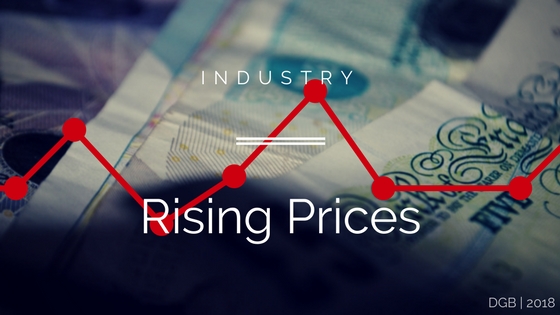The price of windows and doors, and the raw materials to make them have been on the rise for the last few years. And when the EU vote happened and the price of Sterling versus the Dollar and the Euro dropped, they went up further still.
Many blamed frankly astronomical price increases on currency moves. Some even decided to put theirs up hours after the result was final. Which smacks of profiteering but there you go. There has since been gentle pressure to see those increases that were blamed on the currency to be reversed as Sterling has gradually recovered.
Well, other than Brisant being the only company to operate an honest and open pricing policy according to currency movements, no one else has reversed any of those prices increases. At least from what I can see.
They haven’t come down now, and they’re very unlikely to come down in the future. In fact, they’re only going to get higher.
Why they’re not falling
The big mistake by so many companies over the past couple of years was to blame their rising prices, especially fabricators passing on their increases to installers, on currency moves. It conditioned many to think that if this was the reason, that when Sterling recovers, to which is has mostly against the Dollar, they will be reversed.
Indeed, Sterling has become far more stable, and has continued to recover. Against the Dollar more than the Euro. So logic might say that yes, some of those increases should be reversed. They haven’t, and they won’t be. In fact they’re going to get higher. Why? Commodities. Take a look at these charts:
These are three major industrial metals that keep the world ticking, and indeed our industry. They’re all on a trajectory upwards. Copper and Aluminium specifically. When these sorts of commodities go up in price, so does much of everything else further down the supply chain.
So as we see our currency recover, any benefits are offset against raw material price increases. And it’s not just what I’m showing you above. The cost of glass and PVC polymer continues to rise too. In fact the rising glass costs have been some of the most stinging recently.
If you thought prices would be coming down at some point soon, you’re going to be disappointed.
Time to rise
No one likes prices going up when you’re the one that has to pay them. Fabricators don’t like it when systems companies raise their prices to them, and the same goes for fabricators to their installers. It’s a natural human reaction to hold on to as much of your hard earned money as you can. But, after decades of artificially keeping prices unrealistically low (mainly in the PVC sector) by shoddy sales people and sales methods, we’re now seeing that long awaited inflation.
Perhaps not a universally shared view, but I think it is time for prices to rise. For many reasons. Yes, our industry has such a poor quality mindset in so many areas that we choose to sell on price rather than quality, which is one of the reasons why prices have not kept up with inflation. But there are other factors too.
The cost of living continues to rise. If you’re a SME installer you will have fitters you need to pay, sales reps to pay, a wage to take for yourself, tax, utilities etc. £150 per day for a fitter is about the minimum rate now, if they’re going to come away with a decent weekly wage after tax. Who pays for that? The company can’t stump up for it all the time. The end user, in our case the home owner, has to pay for it.
Profit margins for many remain squeezed. Some companies I know are already considering their spending on big ticket expenditure over the next couple of years and looking at how they can spend more productively. There’s only so much internal efficiency savings you can do before you have to start charging home owners for the work you do.
It’s a shame that words like “profit” and “business” have become dirty words in the last few years. But remember, we’re all in this business to make money. To earn profit. To make as much as we can to make sure we and everyone around us can live as comfortably as possible. If you own a business, help run one, or are just employed and the end goal isn’t to come away at the end of the week with a good living, then I suggest you start a charity.
So don’t be thinking prices are going to be coming down, they’re going the other way. My advice would be to very quickly adjust, update your business models, start selling on quality over price and get used to the new norm.
To get weekly updates from DGB sent to your inbox, enter your email address in the space below to subscribe:









